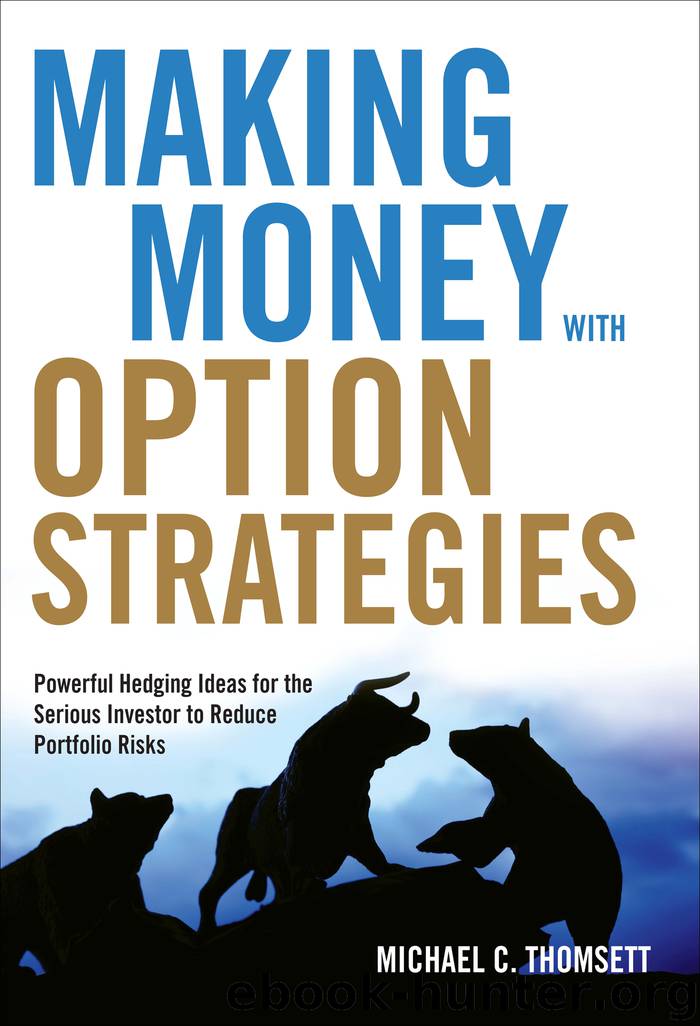Making Money With Option Strategies by Michael C. Thomsett

Author:Michael C. Thomsett
Language: eng
Format: epub
Publisher: Career Press
Published: 2016-03-17T04:00:00+00:00
If you were to hold either of these stocks in your portfolio, both yield a very attractive annual dividend. However, the point to remember is that once the timing of quarterly dividends is taken into account, the picture is changed.
Writing Calls on Stock Already Owned and Appreciated
If you buy shares of stock at the same time you open a covered call, the relationship between underlying price and strike is straightforward. Ideally, the strike has to be higher than your basis in the stock, meaning the price per share you paid at the time of purchase. In the event of exercise, you end up with capital gains or, at worst, a breakeven in the stock. However, covered calls take on a different meaning and a different hedge profile when you have owned stock for a period of time and it has appreciated in value.
In this situation, your concern goes beyond generating current income and has to include the issue of protecting your net gain, even though you do not want to sell shares. This is an endless problem for even the most conservative investor. Should you sell and take profits, concerned that the stock price will decline? Or should you hold onto high-quality shares and ignore the cyclical price changes?
A third choice is to hedge that paper gain with options. There are many methods for this, including both calls and puts. However, even the covered call can be used to manage the appreciated stock in your portfolio.
In most covered calls, you are motivated to write at-the-money or out-of-the-money options. For appreciated stock, this can make sense; if exercised, these positions yield the option premium and capital gains. But other factors have to be considered as well:
1. Timing of a covered call. For appreciated stock, are you willing to risk exercise in less than one year? The long-term capital gains rate is much more attractive than the fully-taxed short-term gain, so if you do write covered calls in this situation, pick expirations that occur after the one-year period. This still contains a degree of risk, especially if ex-dividend occurs before the year has passed. Early exercise could force a short-term gain.
2. Unintended consequences of exercise. With appreciated stock, you might consider writing in-the-money calls. This is an attractive scenario. You still get a capital gain, but much higher call premium represents a nice bump in your overall return. However, if you write a deep in the money call, you face a different risk: An unqualified covered call might end up with capital gains taxed at short-term rates even if the holding period exceeds a full year.
Key Point
The unqualified covered call can lead to higher tax liability because the long-term period is tolled while the call is left open.
Download
This site does not store any files on its server. We only index and link to content provided by other sites. Please contact the content providers to delete copyright contents if any and email us, we'll remove relevant links or contents immediately.
Rich Dad Poor Dad by Robert T. Kiyosaki(6191)
Pioneering Portfolio Management by David F. Swensen(6089)
How To Win Friends and Influence People by Dale Carnegie(4341)
The Money Culture by Michael Lewis(3856)
The Dhandho Investor by Mohnish Pabrai(3572)
The Wisdom of Finance by Mihir Desai(3538)
Liar's Poker by Michael Lewis(3230)
The Intelligent Investor by Benjamin Graham Jason Zweig(2938)
The ONE Thing by Gary Keller(2923)
Mastering Bitcoin: Programming the Open Blockchain by Andreas M. Antonopoulos(2896)
Fooled by Randomness: The Hidden Role of Chance in Life and in the Markets by Nassim Nicholas Taleb(2868)
Rich Dad Poor Dad: What The Rich Teach Their Kids About Money - That The Poor And Middle Class Do Not! by Robert T. Kiyosaki(2839)
Investing For Dummies by Eric Tyson(2802)
How to Win Friends and Influence People by Dale Carnegie(2800)
How to Day Trade for a Living: Tools, Tactics, Money Management, Discipline and Trading Psychology by Andrew Aziz(2788)
Market Wizards by Jack D. Schwager(2546)
Zero Hour by Harry S. Dent Jr. & Andrew Pancholi(2538)
How to Pay Zero Taxes, 2018 by Jeff A. Schnepper(2505)
Rich Dad's Guide to Investing by Robert T. Kiyosaki(2413)
